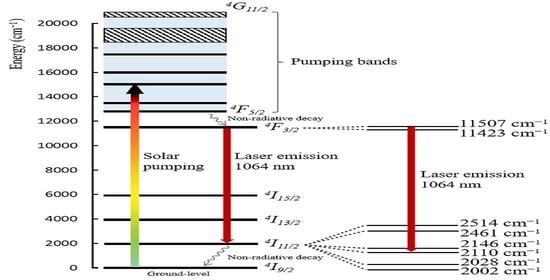Doughnut-Shaped and Top Hat Solar Laser Beams Numerical Analysis
Abstract
:1. Introduction
2. Methods
2.1. Solar Energy Collection and Concentration System with Six Fresnel Lenses
2.2. Solar Laser Head with Six Aspheric Lenses and Six Twisted Light Guides
2.3. Solar Laser Head Design with ZEMAX® Non-Sequential Ray-Tracing Software
2.4. Laser Resonator Design through LASCAD® Software
3. Results
4. Discussion
5. Conclusions
Author Contributions
Funding
Institutional Review Board Statement
Informed Consent Statement
Data Availability Statement
Acknowledgments
Conflicts of Interest
References
- Liang, D.; Almeida, J. Highly efficient solar-pumped Nd:YAG laser. Opt. Express 2011, 19, 26399. [Google Scholar] [CrossRef]
- Summerer, L.; Purcell, O. Concepts for Wireless Energy Transmission via Laser. ESA-Adv. Concepts Team 2008, 1–10. [Google Scholar]
- Hemmati, H.; Biswas, A.; Djordjevic, I.B. Deep-space optical communications: Future perspectives and applications. Proc. IEEE 2011, 99, 2020–2039. [Google Scholar] [CrossRef]
- Lando, M.; Kagan, J.A.; Shimony, Y.; Kalisky, Y.Y.; Noter, Y.; Yogev, A.; Rotman, S.R.; Rosenwaks, S. Solar-pumped solid state laser program. In Proceedings of the 10th Meeting on Optical Engineering in Israel, Tel-Aviv, Israel, 1–6 March 1997; Shaldov, I., Rotman, S.R., Eds.; SPIE: Jerusalem, Israel, 1997; Volume 3110, pp. 196–201. [Google Scholar]
- Rather, J.D.G.; Gerry, E.T.; Zeiders, G.W. Investigation of possibilities for solar powered high energy lasers in space. NASA Tech. Rep. Serv. 1977. Available online: https://ntrs.nasa.gov/search.jsp?R=19770019534 (accessed on 13 May 2021).
- Vasile, M.; Maddock, C.A. Design of a formation of solar pumped lasers for asteroid deflection. Adv. Sp. Res. 2012, 50, 891–905. [Google Scholar] [CrossRef] [Green Version]
- Yabe, T.; Uchida, S.; Ikuta, K.; Yoshida, K.; Baasandash, C.; Mohamed, M.S.; Sakurai, Y.; Ogata, Y.; Tuji, M.; Mori, Y.; et al. Demonstrated fossil-fuel-free energy cycle using magnesium and laser. Appl. Phys. Lett. 2006, 89, 261107. [Google Scholar] [CrossRef]
- Graydon, O. A sunny solution. Nat. Photonics 2007, 1, 495–496. [Google Scholar] [CrossRef]
- Oliveira, M.; Liang, D.; Almeida, J.; Vistas, C.R.; Gonçalves, F.; Martins, R. A path to renewable Mg reduction from MgO by a continuous-wave Cr:Nd:YAG ceramic solar laser. Sol. Energy Mater. Sol. Cells 2016, 155, 430–435. [Google Scholar] [CrossRef]
- Koechner, W. Solid-State Laser Engineerings, 6th ed.; Springer: New York, NY, USA, 2006; ISBN 978-0-387-29338-7. [Google Scholar]
- Duocastella, M.; Arnold, C.B. Bessel and annular beams for materials processing. Laser Photonics Rev. 2012, 6, 607–621. [Google Scholar] [CrossRef]
- Le, H.; Penchev, P.; Henrottin, A.; Bruneel, D.; Nasrollahi, V.; Ramos-de-Campos, J.A.; Dimov, S. Effects of top-hat laser beam processing and scanning strategies in laser micro-structuring. Micromachines 2020, 11, 221. [Google Scholar] [CrossRef] [Green Version]
- Dickey, F.M.; Holswade, S.C. Laser Beam Shaping, Theory and Techniques; Marcel Dekker, Inc.: New York, NY, USA; Basel, Switzerland, 2000; ISBN 9780735405752. [Google Scholar]
- Grojean, R.E.; Feldman, D.; Roach, J.F. Production of flat top beam profiles for high energy lasers. Rev. Sci. Instrum. 1980, 51, 375–376. [Google Scholar] [CrossRef] [PubMed]
- Frieden, B.R. Lossless Conversion of a Plane Laser Wave to a Plane Wave of Uniform Irradiance. Appl. Opt. 1965, 4, 1400. [Google Scholar] [CrossRef]
- Hoffnagle, J.A.; Jefferson, C.M. Design and performance of a refractive optical system that converts a Gaussian to a flattop beam. Appl. Opt. 2000, 39, 5488. [Google Scholar] [CrossRef]
- Duerr, F.; Thienpont, H. Refractive laser beam shaping by means of a functional differential equation based design approach. Opt. Express 2014, 22, 8001. [Google Scholar] [CrossRef] [PubMed]
- Leger, J.R.; Chen, D.; Wang, Z. Diffractive optical element for mode shaping of a Nd:YAG laser. Opt. Lett. 1994, 19, 108. [Google Scholar] [CrossRef]
- Dickey, F.M. Gaussian laser beam profile shaping. Opt. Eng. 1996, 35, 3285. [Google Scholar] [CrossRef]
- Račiukaitis, G.; Stankevičius, E.; Gečys, P.; Gedvilas, M.; Bischoff, C.; Jäger, E.; Umhofer, U.; Völklein, F. Laser processing by using diffractive optical laser beam shaping technique. J. Laser Micro Nanoeng. 2011, 6, 37–43. [Google Scholar] [CrossRef]
- Ding, X.Y.; Ren, Y.X.; Lu, R. De Shaping super-Gaussian beam through digital micro-mirror device. Sci. China Phys. Mech. Astron. 2015, 58, 1–6. [Google Scholar] [CrossRef]
- Forbes, A.; Dudley, A.; McLaren, M. Creation and detection of optical modes with spatial light modulators. Adv. Opt. Photonics 2016, 8, 200. [Google Scholar] [CrossRef]
- Litvin, I.A.; Forbes, A. Intra cavity flat top beam generation. Opt. Express 2009, 17, 15891–15903. [Google Scholar] [CrossRef] [Green Version]
- Litvin, I.A.; King, G.; Strauss, H. Beam shaping laser with controllable gain. Appl. Phys. B Lasers Opt. 2017, 123, 1–5. [Google Scholar] [CrossRef]
- Kana, E.T.; Bollanti, S.; Di Lazzaro, P.; Murra, D.; Bouba, O.; Onana, M.B. Laser beam homogenization: Modeling and comparison with experimental results. Opt. Commun. 2006, 264, 187–192. [Google Scholar] [CrossRef]
- Wallace, L. Efficient Transformation of Gaussian Beams into Uniform, Rectangular Intensity Distributions; Coherent, Inc.: Santa Clara, CA, USA, 2011. [Google Scholar]
- Homburg, O.; Mitra, T. Gaussian-to-top-hat beam shaping: An overview of parameters, methods, and applications. In Proceedings of the Laser Reson. Microresonators Beam Control XIV, San Francisco, CA, USA, 21–26 January 2012; Volume 8236, p. 82360A. [Google Scholar] [CrossRef]
- Hracek, B.; Bäuerle, H. New Ways to Generate Flat-Top Profiles. Opt. Photonik 2015, 10, 16–18. [Google Scholar] [CrossRef]
- Santarsiero, M.; Borghi, R. Correspondence between super-Gaussian and flattened Gaussian beams. J. Opt. Soc. Am. A 1999, 16, 188–190. [Google Scholar] [CrossRef]
- Shealy, D.L.; Hoffnagle, J.A. Laser beam shaping profiles and propagation. Appl. Opt. 2006, 45, 5118–5131. [Google Scholar] [CrossRef]
- Kaszei, K.; Boone, C. Flat-Top Laser Beams: Their Uses and Benefits. Available online: https://www.laserfocusworld.com/optics/article/14197298/flattop-laser-beams-their-uses-and-benefits (accessed on 17 May 2021).
- Fuse, K. Beam Shaping for Advanced Laser Materials Processing. Laser Tech. J. 2015, 12, 19–22. [Google Scholar] [CrossRef] [Green Version]
- Hung, Y.-J.; Chang, H.-J.; Chang, P.-C.; Lin, J.-J.; Kao, T.-C. Employing refractive beam shaping in a Lloyd’s interference lithography system for uniform periodic nanostructure formation. J. Vac. Sci. Technol. B Nanotechnol. Microelectron. Mater. Process. Meas. Phenom. 2017, 35, 030601. [Google Scholar] [CrossRef]
- Ramos, S.; Stork, W.; Heussner, N. Multiple-pulse damage thresholds of retinal explants using top hat profiles. In Proceedings of the Optical Interactions with Tissue and Cells XXXI, San Francisco, CA, USA, 1–2 February 2020; Volume 11238, p. 112380D. [Google Scholar] [CrossRef]
- Zhang, Y.; Wu, C.; Song, Y.; Si, K.; Zheng, Y.; Hu, L.; Chen, J.; Tang, L.; Gong, W. Machine learning based adaptive optics for doughnut-shaped beam. Opt. Express 2019, 27, 16871. [Google Scholar] [CrossRef]
- Tumkur, T.U.; Voisin, T.; Shi, R.; Depond, P.J.; Roehling, T.T.; Wu, S.; Crumb, M.F.; Roehling, J.D.; Guss, G.; Khairallah, S.A.; et al. Nondiffractive beam shaping for enhanced optothermal control in metal additive manufacturing. Sci. Adv. 2021, 7, 9358–9373. [Google Scholar] [CrossRef]
- Kiss, Z.J.; Lewis, H.R.; Duncan, R.C. Sun pumped continuous optical maser. Appl. Phys. Lett. 1963, 2, 93–94. [Google Scholar] [CrossRef]
- Maiman, T.H. Stimulated optical radiation in Ruby. Nature 1960, 187, 493–494. [Google Scholar] [CrossRef]
- Arashi, H.; Oka, Y.; Sasahara, N.; Kaimai, A.; Ishigame, M. A Solar-Pumped cw 18 W Nd:YAG Laser. Jpn. J. Appl. Phys. 1984, 23, 1051–1053. [Google Scholar] [CrossRef]
- Weksler, M.; Shwartz, J. Solar-pumped solid-state lasers. IEEE J. Quantum Electron. 1988, 24, 1222–1228. [Google Scholar] [CrossRef]
- Lando, M.; Kagan, J.; Linyekin, B.; Dobrusin, V. A solar-pumped Nd:YAG laser in the high collection efficiency regime. Opt. Commun. 2003, 222, 371–381. [Google Scholar] [CrossRef]
- Liang, D.; Almeida, J.; Vistas, C.R.; Guillot, E. Solar-pumped Nd:YAG laser with 31.5 W/m2 multimode and 7.9 W/m2 TEM00-mode collection efficiencies. Sol. Energy Mater. Sol. Cells 2017, 159, 435–439. [Google Scholar] [CrossRef]
- Liang, D.; Vistas, C.R.; Tibúrcio, B.D.; Almeida, J. Solar-pumped Cr:Nd:YAG ceramic laser with 6.7% slope efficiency. Sol. Energy Mater. Sol. Cells 2018, 185, 75–79. [Google Scholar] [CrossRef]
- Yabe, T.; Ohkubo, T.; Uchida, S.; Yoshida, K.; Nakatsuka, M.; Funatsu, T.; Mabuti, A.; Oyama, A.; Nakagawa, K.; Oishi, T.; et al. High-efficiency and economical solar-energy-pumped laser with Fresnel lens and chromium codoped laser medium. Appl. Phys. Lett. 2007, 90, 261120. [Google Scholar] [CrossRef]
- Dinh, T.H.; Ohkubo, T.; Yabe, T.; Kuboyama, H. 120 watt continuous wave solar-pumped laser with a liquid light-guide lens and an Nd:YAG rod. Opt. Lett. 2012, 37, 2670–2672. [Google Scholar] [CrossRef]
- Liang, D.; Almeida, J. Solar-Pumped TEM00 Mode Nd:YAG laser. Opt. Express 2013, 21, 25107. [Google Scholar] [CrossRef] [PubMed]
- Xu, P.; Yang, S.; Zhao, C.; Guan, Z.; Wang, H.; Zhang, Y.; Zhang, H.; He, T. High-efficiency solar-pumped laser with a grooved Nd:YAG rod. Appl. Opt. 2014, 53, 3941–3944. [Google Scholar] [CrossRef]
- Guan, Z.; Zhao, C.; Li, J.; He, D.; Zhang, H. 32.1 W/m2 continuous wave solar-pumped laser with a bonding Nd:YAG/YAG rod and a Fresnel lens. Opt. Laser Technol. 2018, 107, 158–161. [Google Scholar] [CrossRef]
- Liang, D.; Almeida, J.; Tibúrcio, B.; Catela, M.; Garcia, D.; Costa, H.; Vistas, C. Seven-rod pumping approach for the most efficient production of TEM00-mode solar laser power by a Fresnel lens. J. Sol. Energy Eng. 2021, 143, 1–28. [Google Scholar] [CrossRef]
- Liang, D.; Vistas, C.R.; Almeida, J.; Tibúrcio, B.D.; Garcia, D. Side-pumped continuous-wave Nd:YAG solar laser with 5.4% slope efficiency. Sol. Energy Mater. Sol. Cells 2019, 192, 147–153. [Google Scholar] [CrossRef]
- Almeida, J.; Liang, D.; Vistas, C.R. A doughnut-shaped Nd:YAG solar laser beam. Opt. Laser Technol. 2018, 106, 1–6. [Google Scholar] [CrossRef]
- Vistas, C.R.; Liang, D.; Almeida, J.; Tibúrcio, B.D.; Garcia, D. A doughnut-shaped Nd:YAG solar laser beam with 4.5 W/m2 collection efficiency. Sol. Energy 2019, 182, 42–47. [Google Scholar] [CrossRef]
- Rioux, M.; Tremblay, R.; Bélanger, P.A. Linear, annular, and radial focusing with axicons and applications to laser machining. Appl. Opt. 1978, 17, 1532. [Google Scholar] [CrossRef]
- Cherezova, T.; Chesnokov, S.; Kaptsov, L.; Kudryashov, A. Doughnut-like laser beam output formation by intracavity flexible controlled mirror. Opt. Express 1998, 3, 180. [Google Scholar] [CrossRef]
- Litvin, I.A.; Ngcobo, S.; Naidoo, D.; Ait-Ameur, K.; Forbes, A. Doughnut laser beam as an incoherent superposition of two petal beams. Opt. Lett. 2014, 39, 704. [Google Scholar] [CrossRef] [Green Version]
- Bernardes, P.H.; Liang, D. Solid-state laser pumping by light guides. Appl. Opt. 2006, 45, 3811–3816. [Google Scholar] [CrossRef]
- Lando, M.; Shimony, Y.; Benmair, R.M.J.; Abramovich, D.; Krupkin, V.; Yogev, A. Visible solar-pumped lasers. Opt. Mater. 1999, 13, 111–115. [Google Scholar] [CrossRef]
- Liang, D.; Almeida, J.; Garcia, D. Comparative Study of Cr:Nd:YAG and Nd:YAG Solar Laser Performances. In Proceedings of the 8th Iberoamerican Optics Meeting and 11th Latin American Meeting on Optics, Lasers, and Applications, Porto, Portugal, 22–26 July 2013; Volume 8785, p. 87859Y. [Google Scholar]
- Vistas, C.R.; Liang, D.; Almeida, J.; Tibúrcio, B.D.; Garcia, D.; Catela, M.; Costa, H.; Guillot, E. Ce:Nd:YAG side-pumped solar laser. J. Photonics Energy 2021, 11, 1–9. [Google Scholar] [CrossRef]
- Lupei, V.; Lupei, A.; Gheorghe, C.; Ikesue, A. Emission sensitization processes involving Nd3+ in YAG. J. Lumin. 2016, 170, 594–601. [Google Scholar] [CrossRef]
- Zhao, B.; Zhao, C.; He, J.; Yang, S. The study of active medium for solar-pumped solid-state lasers. Acta Opt. Sin. 2007, 27, 1797–1801. [Google Scholar]
- ASTM International. ASTM Standard G173-03, Standard Tables for Reference Solar Spectral Irradiances: Direct Normal and Hemispherical on 37 Tilted Surface; ASTM: West Conshohocken, PS, USA, 2012. [Google Scholar]
- Liang, D.; Almeida, J.; Vistas, C.R.; Guillot, E. Solar-pumped TEM00 mode Nd:YAG laser by a heliostat—Parabolic mirror system. Sol. Energy Mater. Sol. Cells 2015, 134, 305–308. [Google Scholar] [CrossRef]
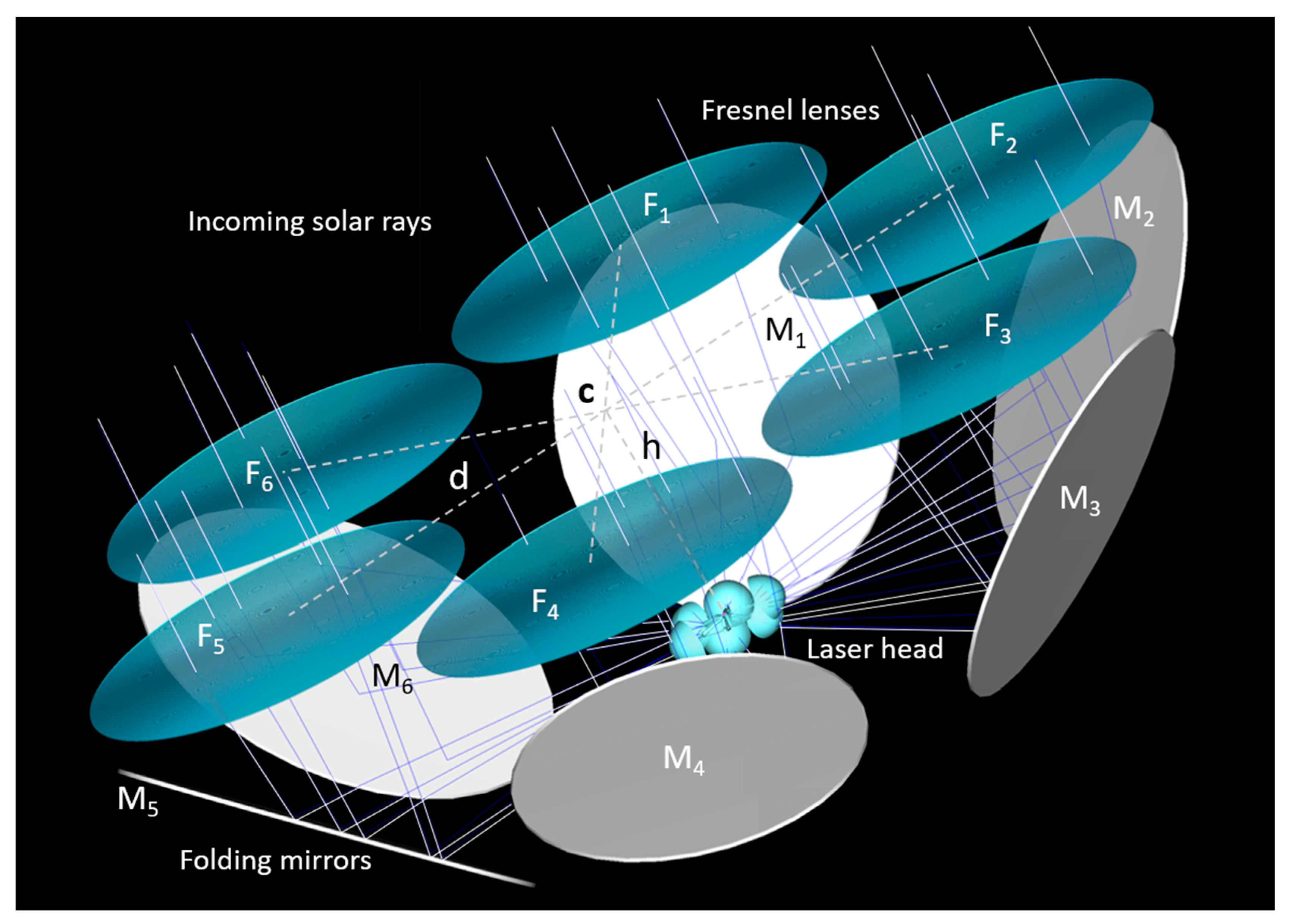

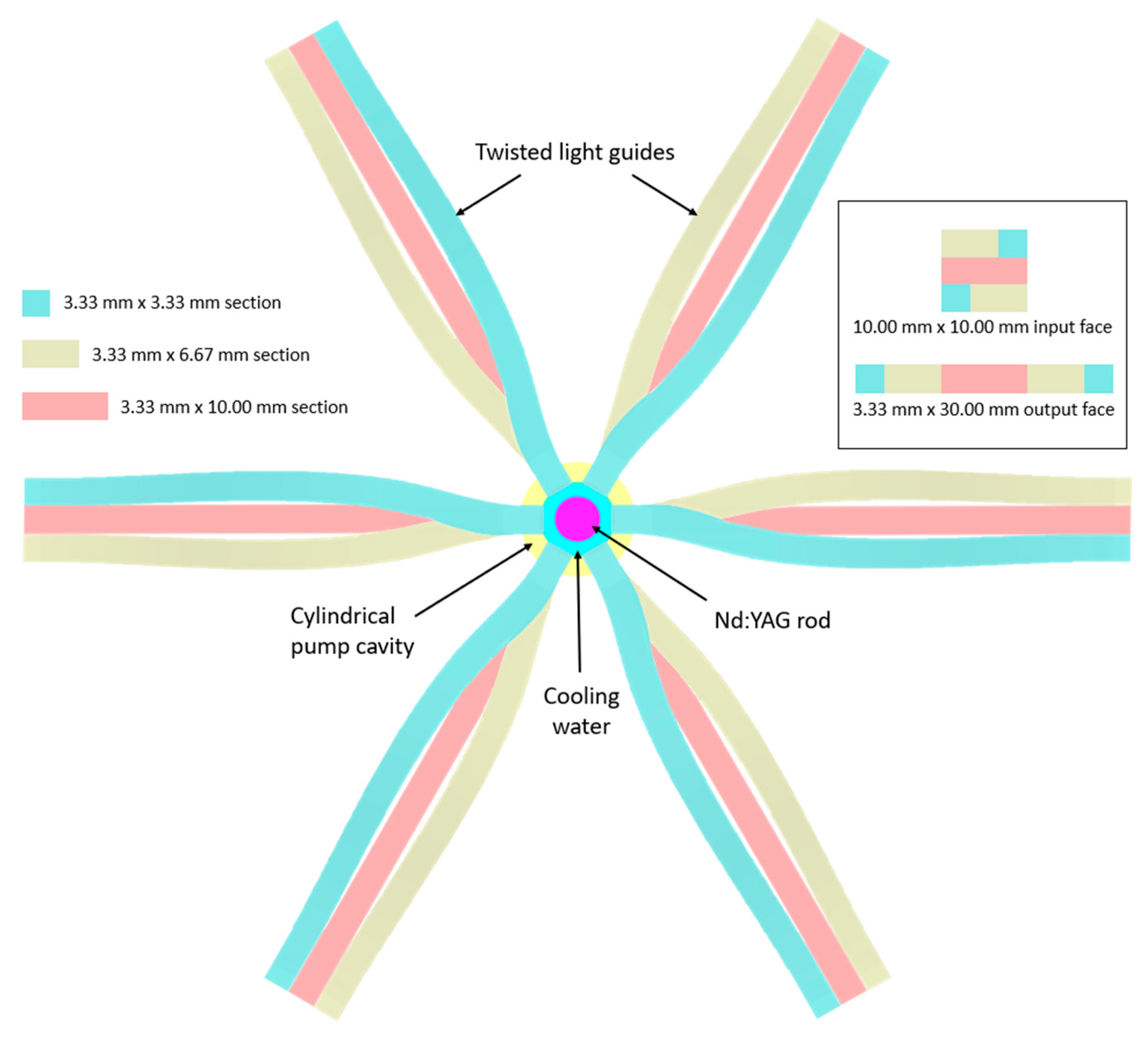
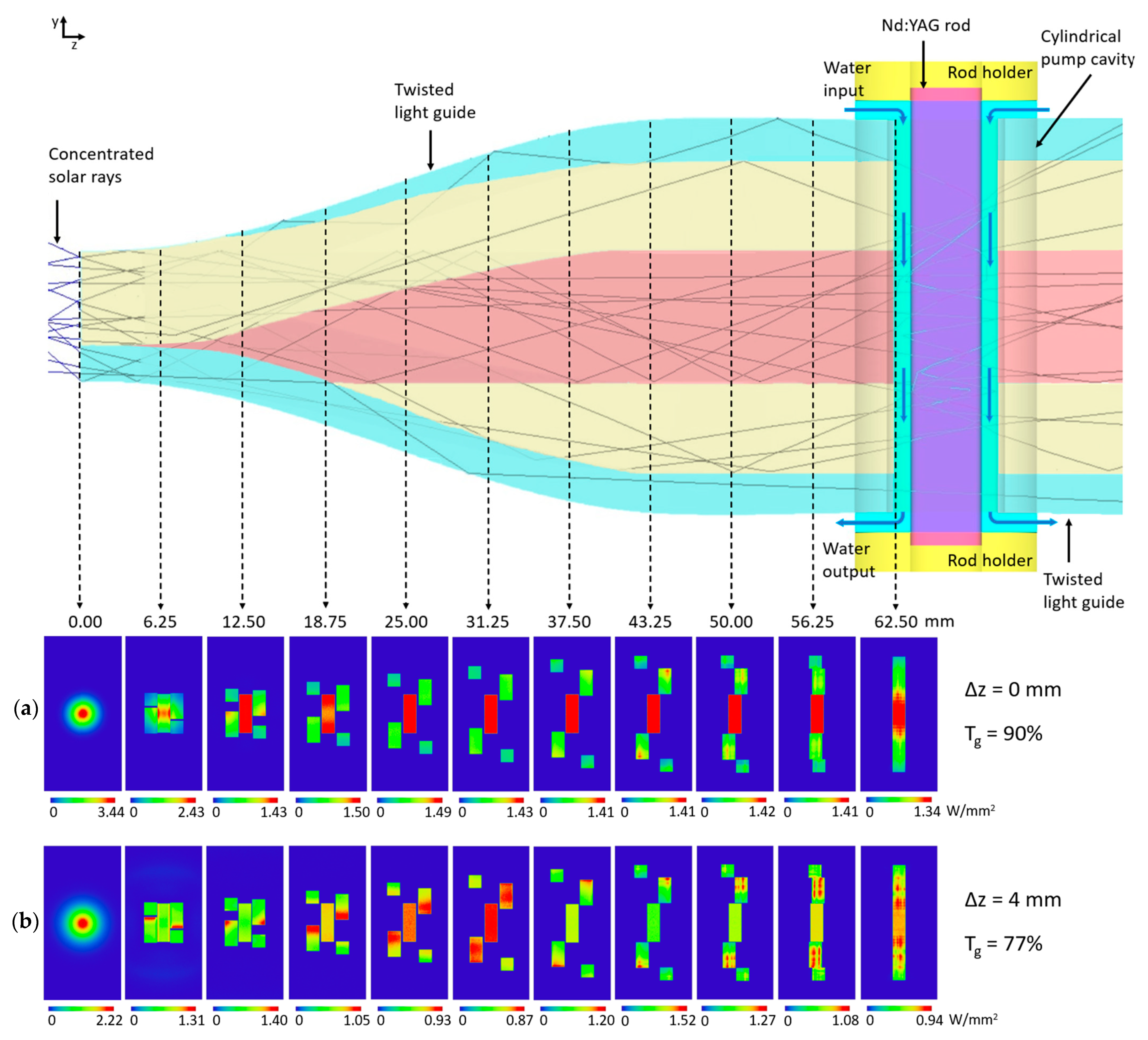

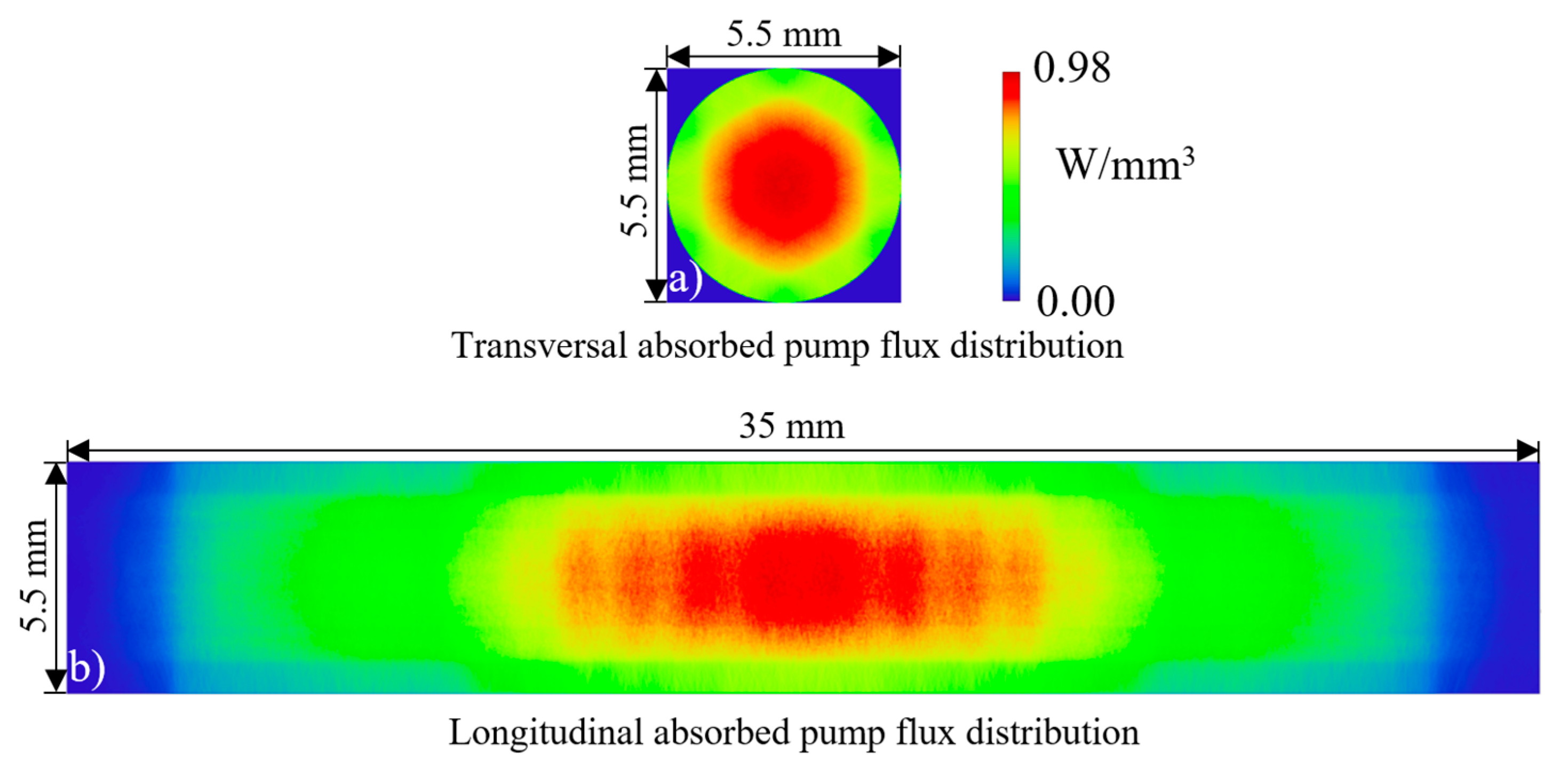
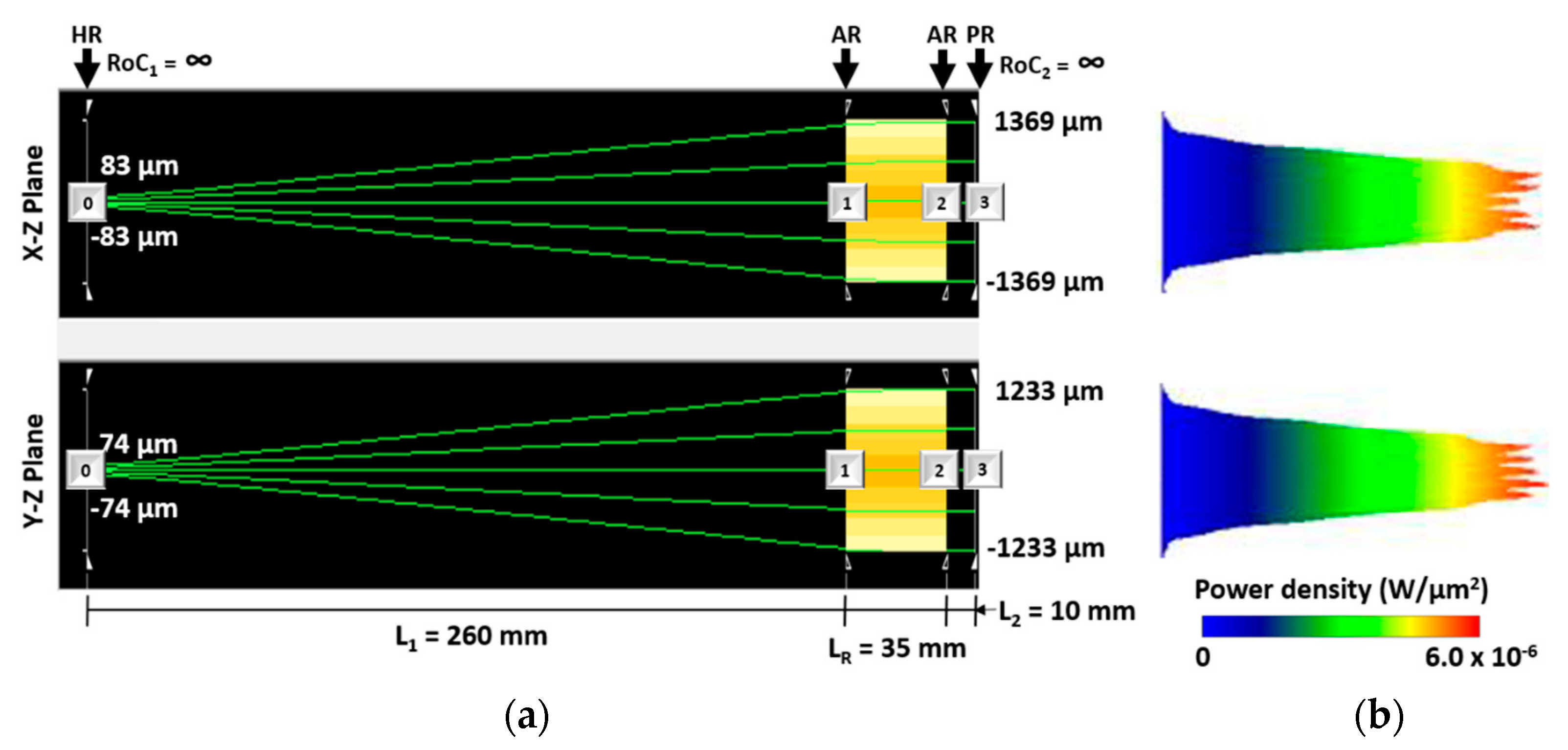
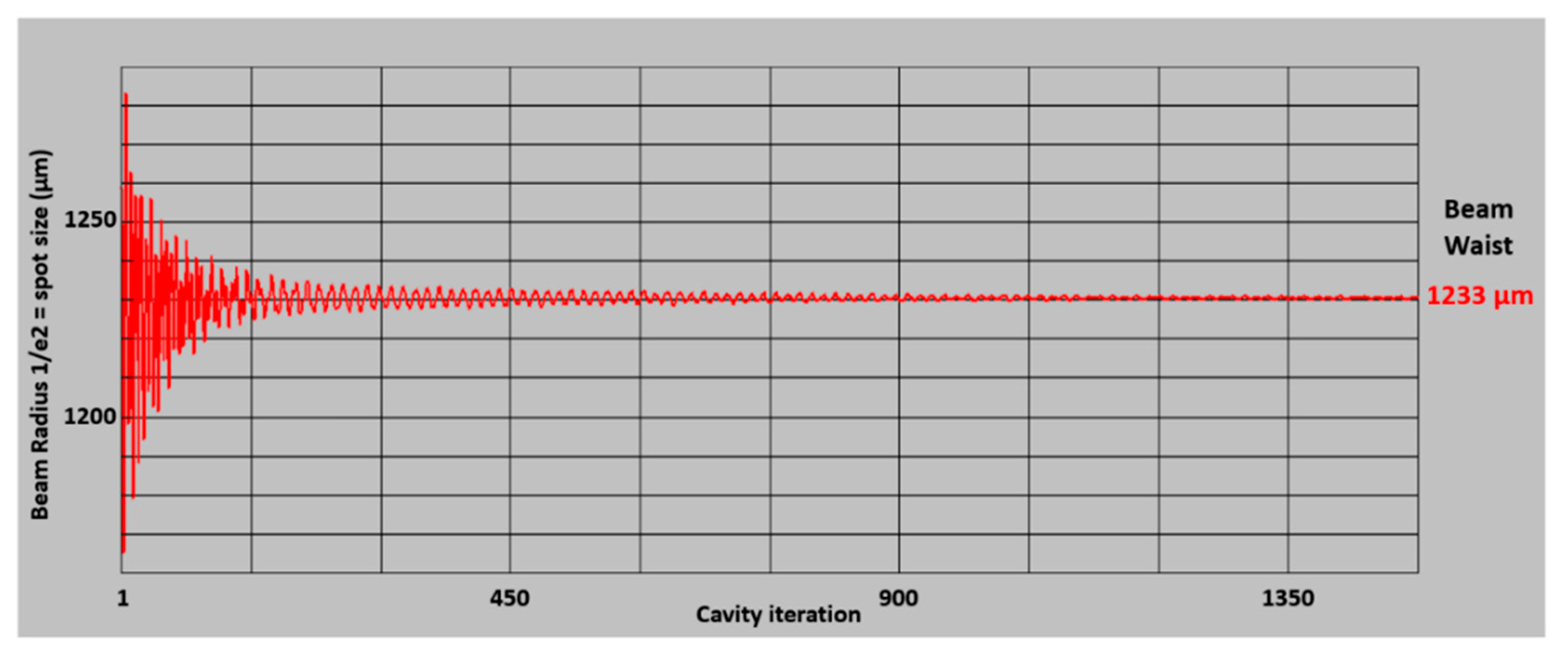
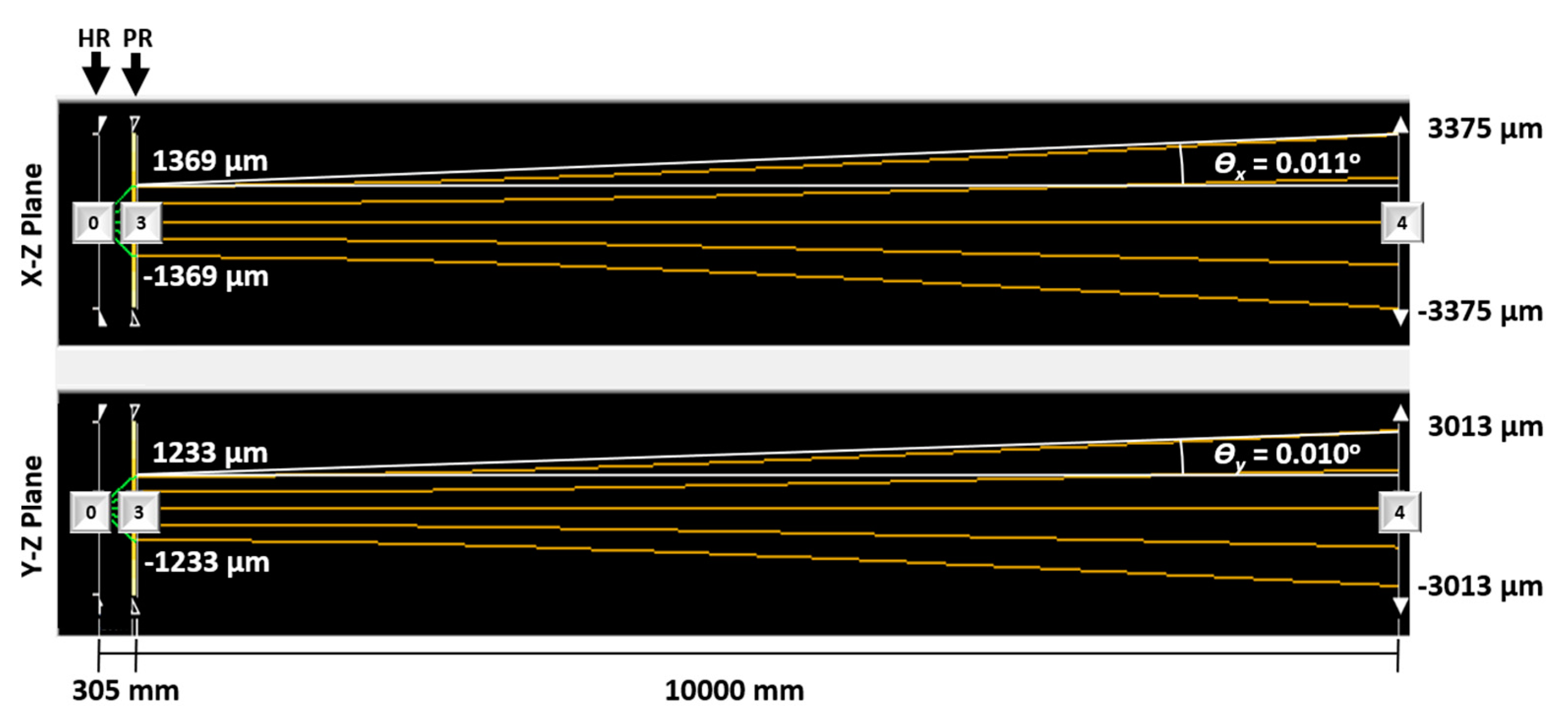
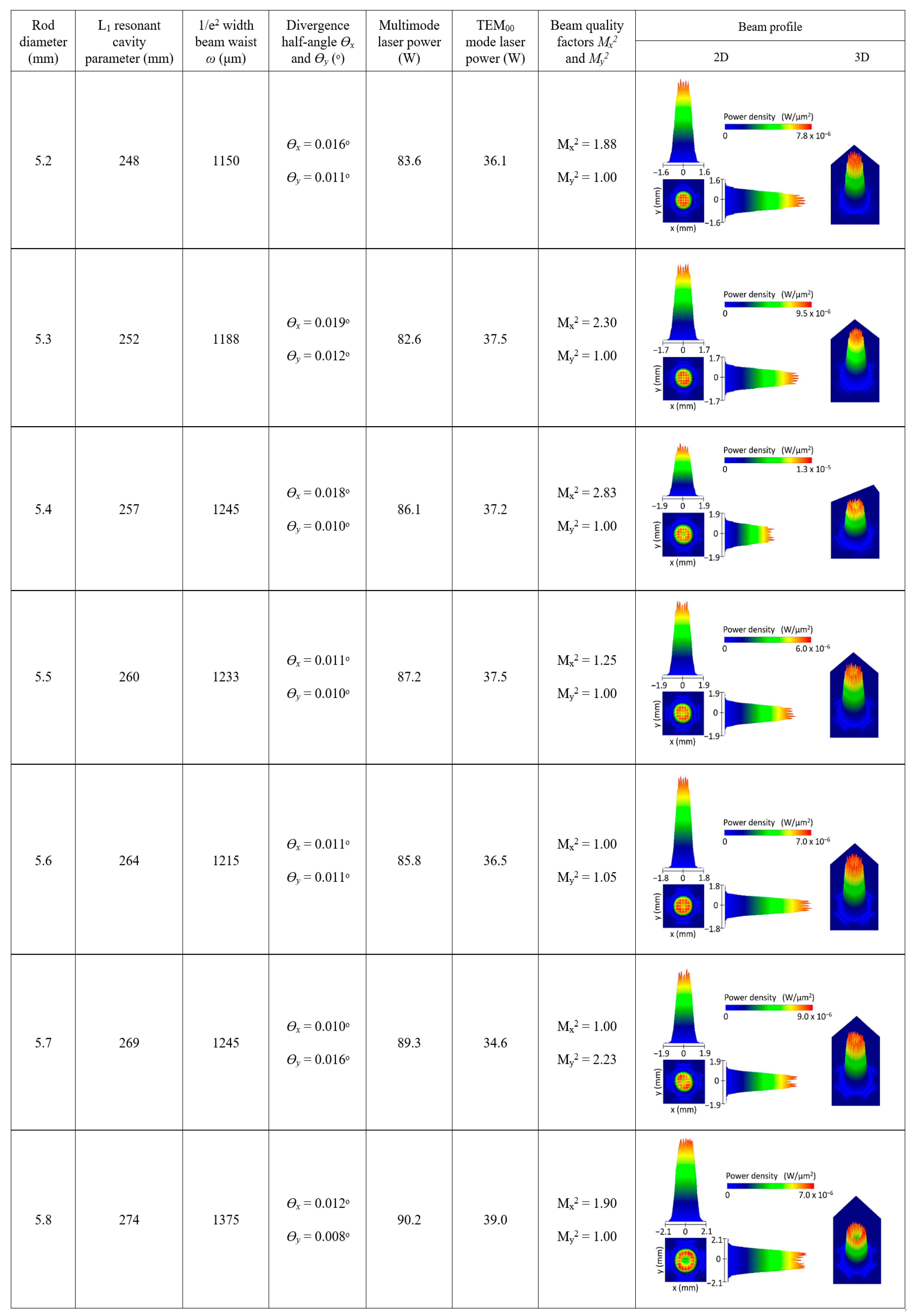

| Scheme | Primary Concentrator | Laser Mode | Collection Efficiency (W/m2) | Conversion Efficiency (%) | Beam Quality Factors |
|---|---|---|---|---|---|
 Liang et al., 2013 [46] (Experimental) | Fresnel lens | Multimode | 10.3 | 1.16 | Not reported |
| TEM00 | 2.93 | 0.64 | Mx2 ≈ My2 < 1.1 | ||
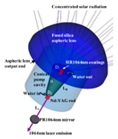 Liang et al., 2017 [42] (Experimental) | Parabolic mirror | Multimode | 31.5 | 2.4 | Mx2 ≈ My2 = 53.4 |
| TEM00 | 7.9 | 0.60 | Mx2 ≈ My2 < 1.2 | ||
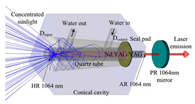 Guan et al., 2018 [48] (Experimental) | Fresnel lens | Multimode | 32.1 | 3.31 | Mx2 ≈ My2 = 61.0 |
 Vistas et al., 2018 [52] (Experimental) | Parabolic mirror | TEM01* | 4.5 | 0.54 | Not reported |
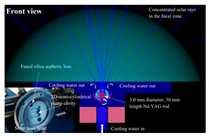 Liang et al., 2019 [50] (Experimental) | Parabolic mirror | Multimode | 17.0 | 2.43 | Mx2 ≈ My2 = 16.8 |
| TEM00 | 3.1 | 0.40 | Not reported | ||
| TEM01* | 3.2 | 0.46 | Not reported | ||
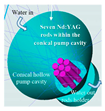 Liang et al., 2021 [49] (Numerical) | Fresnel lens | Multimode | 23.3 | 2.82 | Not reported |
| TEM00 | 13.7 | 1.44 | Mx2 = 1.00 My2 = 1.04 |
| Scheme | Laser Mode | Collection Efficiency (W/m2) | Conversion Efficiency (%) | Beam Quality Factors |
|---|---|---|---|---|
| Vistas et al., 2018 [52] (Experimental) | TEM01* | 4.5 | 0.54 | Not reported |
| Liang et al., 2021 [49] (Numerical) | Multimode | 23.3 | 2.82 | Not reported |
| TEM00 | 13.7 | 1.44 | Mx2 = 1.00 My2 = 1.04 | |
| Present work (Numerical) | Multimode | 22.6 | 2.37 | Not reported |
| TEM01* | 9.8 | 1.03 | Mx2 = 1.90 My2 = 1.00 | |
| Top hat beam | 9.4 | 0.99 | Mx2 = 1.25 My2 = 1.00 |
Publisher’s Note: MDPI stays neutral with regard to jurisdictional claims in published maps and institutional affiliations. |
© 2021 by the authors. Licensee MDPI, Basel, Switzerland. This article is an open access article distributed under the terms and conditions of the Creative Commons Attribution (CC BY) license (https://creativecommons.org/licenses/by/4.0/).
Share and Cite
Catela, M.; Liang, D.; Vistas, C.R.; Garcia, D.; Tibúrcio, B.D.; Costa, H.; Almeida, J. Doughnut-Shaped and Top Hat Solar Laser Beams Numerical Analysis. Energies 2021, 14, 7102. https://doi.org/10.3390/en14217102
Catela M, Liang D, Vistas CR, Garcia D, Tibúrcio BD, Costa H, Almeida J. Doughnut-Shaped and Top Hat Solar Laser Beams Numerical Analysis. Energies. 2021; 14(21):7102. https://doi.org/10.3390/en14217102
Chicago/Turabian StyleCatela, Miguel, Dawei Liang, Cláudia R. Vistas, Dário Garcia, Bruno D. Tibúrcio, Hugo Costa, and Joana Almeida. 2021. "Doughnut-Shaped and Top Hat Solar Laser Beams Numerical Analysis" Energies 14, no. 21: 7102. https://doi.org/10.3390/en14217102
APA StyleCatela, M., Liang, D., Vistas, C. R., Garcia, D., Tibúrcio, B. D., Costa, H., & Almeida, J. (2021). Doughnut-Shaped and Top Hat Solar Laser Beams Numerical Analysis. Energies, 14(21), 7102. https://doi.org/10.3390/en14217102







